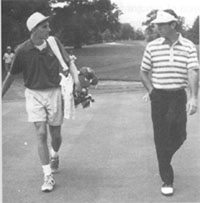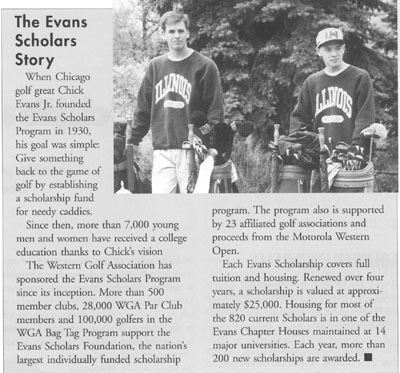
SPECIAL FOCUS
A Case for Caddies
Golf greats Ben Hogan and Chick Evans caddied. It's a long-standing
tradition that's becoming more common at public courses.
BY JEFF HARRISON
Caddies have been an essential part of the game of golf since the Company of Edinburgh Golfers in Scotland formed the first golf club in 1744. Today, the close relationship between golfer and caddie remains unique in sport.
Golf greats Ben Hogan, Byron Nelson, Gene Sarazen and Chick Evans all caddied. Current Senior Tour stars Tom Weiskopf and Lee Trevino were introduced to the game of golf through caddying. Also, comedian Bill Murray, investment guru Peter Lynch, and even President Clinton caddied as youngsters.
Today most of the country's caddie programs are concentrated in the Midwest and Northeast at private clubs. These areas have an advantage over other parts of the country because of a strong tradition of caddies and a golf season that coincides with the school year, making it very easy for teenagers to caddie. Also, a growing number of public courses are offering their golfers the alternative of using caddies to enjoy the game of golf as it was originally played.

Benefits of a Caddie Program
An opportunity for golfers to walk. Caddies allow golfers who are physically able the opportunity to walk. Walking adds enjoyment to a round of golf, and many golfers believe that caddies even help lower their scores.
"I also believe that caddies speed up play," says Rich Peterson, a Western Golf Association (WGA) director from Park Ridge. "A good caddie enhances my concentration on the game. They remind me of yardage and wind conditions which helps me in visualizing my shot."
A better conditioned golf course. Well-trained caddies have a positive effect on the condition of a golf course.
"Not only do they assist in keeping the course manicured by replacing divots, raking bunkers, and repairing ball marks, but the use of caddies significantly impacts the condition of the golf course by reducing the number of golf carts that are used," explains Bob Maibusch, golf course superintendent at Hinsdale Golf Club in Clarendon Hills, 111.
"In my opinion, the two most damaging things to a golf course are the failure to repair ball marks on greens and the use of golf carts."
A built-in labor pool. Caddies programs provide an excellent source of labor for courses to fill positions in various departments.
"We have filled many positions—including bag room staff, grounds staff and bus persons—with former caddies," says Mike Stott, general manager of Tam 0 Shanter Country Club in West Bloomfield, Mich. "They have already proven themselves to be good employees, so it makes the hiring process that much easier."
Benefits to the community. Caddie programs provide an opportunity for golf courses to give something back to their communities. Caddying provides a safe working environment along with introducing young men and women to positive role
May/June 1998 / 41
SPECIAL FOCUS
models. Caddies develop good work habits, learn about the game of golf, improve their communication skills and learn about the value of money.
A renewed interest in caddies
For years, golf traditionalists have stressed the advantages of using caddies. Their arguments have gained national attention in recent years due to the growing efforts of golf publications and organizations.
In 1993, Golf Digest launched a yearlong "Caddie Crusade" to promote the use of caddies and return golf to its roots as a walking game. The U.S. Golf Association's "Walking Campaign" also sent a message around the country that walking is an integral part of the game of golf.
National and state golf associations such as the Western Golf Association have produced publications, brochures, and posters, to promote walking and the use of caddies. The PGA of America also has recognized the benefits of walking and taking caddies.
Much of the recent publicity has been fueled by a growing national emphasis on fitness. Walking is the most common form of leisure time activity enjoyed by Americans, and walking 18 holes is equivalent to five miles, notes Dr. Edward Palank, chief cardiologist from the New Hampshire Heart Institute.
In a four-month study of 30 golfers, Dr. Palank concluded that "(hose who walked the course three or more times a week had a lower risk of developing heart disease." He also mentioned that "the relationship of the bad cholesterol to the good cholesterol improved and walking led to a reduction in one's overall weight."
Characteristics of a successful caddie program
A well-qualified caddie superintendent. The caddie superintendent must be able to get along with the head professional, the members, the staff, the caddies and their parents. Besides the duties of supervising, assigning loops, paying the caddies, and recruiting/training, the caddie superintendent oftentimes is also in charge of basically the entire outside operations (bag) room, range, carts, etc.). Depending upon the size of the program, the caddie superintendent can be hired anywhere from three months to a full-time position.
Effective recruiting and training. The most successful caddie programs have the luxury of recruiting by word of mouth. Current caddies tell their friends or their brothers and sisters about all the benefits involved with caddying. Caddies also are recruited through junior high schools, high schools, or by advertising in newspapers. Training is quite possibly the most important aspect of a successful caddie program.
Appropriate payment of caddies. Pay scales for caddies vary. Golfers can pay their caddies directly in cash or they can sign a ticket or "chit." The rate should be high enough to be competitive with the other courses in the area. It's definitely important to have some sort of incentive for the caddies to perform well on the course, whether it be in the form of tips or a bonus system in which the caddie is rewarded at the end of the year with cash and/or prizes. Also, most courses classify their caddies in one of three categories Honor, A and B. It's important to have more than one class because it will mean more money and will provide an incentive for the younger caddies to achieve the top rank. A lack of proper pay or incentives may encourage a caddie to become simply a "bag toter."
Other factors contributing to a successful caddie program include:
• A caddie committee, which should meet three times a year (before, during, and after the season).
• Effective use of course newsletters to inform golfers about the caddie program.
• Attractive uniforms, such as T-shirts, collared or polo shirts, bibs or smocks, coveralls.
Starting a Caddie Program
Officials starting a caddie program should remember that successful caddie programs can be small in size and may not need to incorporate all of the above characteristics. In fact, it is a good idea to start with small numbers because you can always recruit more caddies later if needed. A successful program depends mostly upon the support of the golfers. The program is a success if the golfers and the caddies are happy.
Also, courses might consider using a reservation system to assign caddies rather than having all caddies report to work each morning. A reservation system works best when the golf staff asks the members as they are reserving tee times if they would like a caddie. This should be done at least 24 hours in advance.
Legal Issues
Legal issues regarding caddies should be reviewed carefully with legal counsel before starting a caddie program. At the majority of courses with existing programs, caddies are considered independent contractors. No federal laws define an employment category for caddies. Main areas of concern for courses today regard issues involving the following: independent contractor status vs. employee of the course; workers' compensation coverage; wage and hour requirements; and methods of payment.
In some states, efforts have been made to clarify the status of caddies. Oregon and Illinois were successful in exempting caddies as employees of the course. Legislation is pending in Congress that would make such exemptions national.
Future of Caddie Programs
The two most important factors dictating the continued success of caddie programs are: 1) better training of the caddies, and 2) a high level of golfer awareness and participation. If having a caddie becomes more of a burden than a pleasure, then many golfers will choose to take a cart or carry their own clubs. That is why proper training is so important. The courses can also do a better job of promoting
42 / Illinois Parks and Recreation
A CASE FOR CADDIES
the program through the club newsletter, mailings and special activities.
Whatever the method, the goal is the same for all courses with caddie programs-to preserve the tradition and ensure that future generations of golfers benefit from the invaluable service provided by caddies.
Courses with caddie programs realize that caddies provide innumerable benefits to their golfers and communities. Courses are better conditioned, golfers receive maximum enjoyment while playing golf and their young people benefit from the opportunity to be employed in a safe, nurturing environment.
WGA Services Available
The Western Golf Association (WGA) in Golf, Ill., offers a variety of services to support caddie programs.
The WGA caddie services director travels throughout the country much of the year assisting courses with their programs, starting new caddie programs and providing packets of information. Also, the WGA has produced resource materials, including:
• Caddie Training Manual. A 30-page comprehensive guide for beginner caddies, the manual is ideal for young men and women who are interested in learning the art of caddying.
• Caddie Training Video. A 40-minute training video for first-year caddies, which can also be used as a refresher course for experienced caddies.
• Materials Promoting Walking. Brochures and posters have been distributed by the thousands to clubs and courses. These "If You Walk..." items are used to encourage players to walk and take caddies.
The WGA also has conducted various events such as caddie seminars, state caddie championships and state caddie golf challenges. For more information, contact the Western Golf Association at 847.724.4600.
JEFF HARRISON
is the associate educational director of the Western Golf Association/Evans
Scholars Foundation.

May/June 1998/ 43